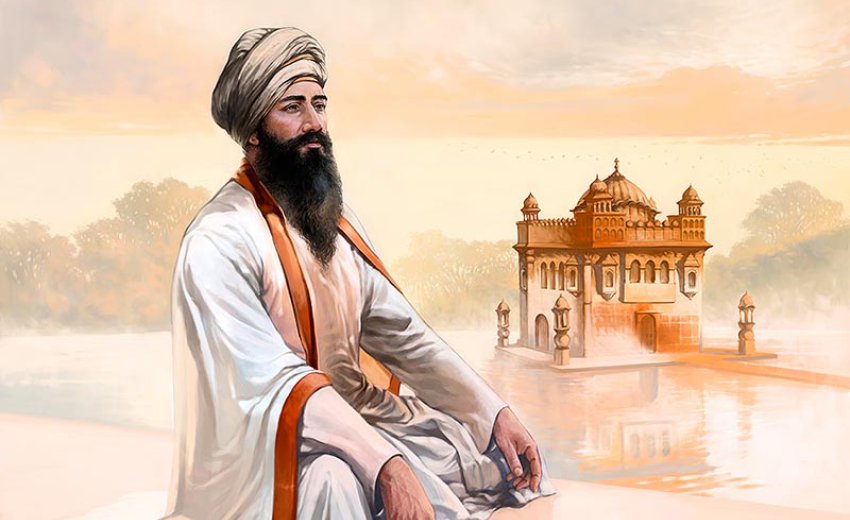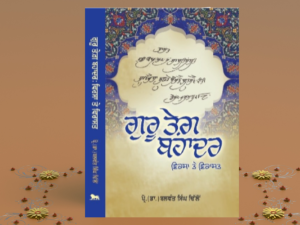Introduction
Guru Tegh Bahadur Sahib (1 April 1621 – 11 November 1675) was the youngest of the five sons of Guru Hargobind Sahib, the sixth Sikh Guru, and his wife Nanaki. He became the 9th Guru of Sikhs on 20 March 1665. His hymns (Gurbani) were included in Aad Guru Granth Sahib, compiled by Guru Arjan Dev in 1604, by Guru Gobind Singh Jee at Talwandi Sabo (Damdama Sahib) in the Damdami Bir. The total number of his hymns is one hundred and fifteen in fifteen raagas.
Aurangzeb wanted to make India an Islamic country. A delegation of Kashmiri Pundits led by Kirpa Ram Datt reached Anandpur and pleaded with Guru Tegh Bahadur to save them from the extreme cruelty of Aurangzeb to convert them to Islam. They, on the advice of the Guru, told the Mughal authorities that they would willingly embrace Islam, if Guru Tegh Bahadur did the same. It was for the first time in the history of religions that the Guru was going to fight a battle on behalf of those of a belief system which he himself did not subscribe to, a belief system the basics of which Guru Nanak had rejected.
Recently, the first author (HSV) reviewed the book authored by Gurmukh Singh (GS) [1-3]. The author reveals the purpose of writing this book: "The main reason for this publication is that earlier publications about the life and martyrdom of Guru Tegh Bahadur either do scant justice to the Guru’s active life or have been written more like fiction in the traditional saakhi (story-telling) style. One example is an otherwise informative biography of Guru Tegh Bahadur by Dr Tarlochan Singh which is written more like a historical novel" [4].
Life of Guru Tegh Bahadur
Most of the accounts of his life portray Tegh Bahadur as a person who was a renunciate in life, who remained absorbed in meditation most of his time and did not bother about the affairs of the world. GS rejects all this false information in his well researched book. He has tried to remove the cobwebs created by other authors by his research oriented approach of sifting the facts from fiction. According to GS, "Guru Tegh Bahadur was trained as a warrior by his father and he participated in most of the battles fought by Guru Hargobind. As a matter of fact, he fought so bravely in the battle of Kartarpur in April 1635, when he was just 14 years old, that his father, Guru Hargobind, changed his family name from Tyag Mal to Tegh Bahadur (the fearless master of the sword)".
GS quotes Harbans Singh [5] who sums up the mission and life of Tegh Bahadur in Baba Bakala as follows: “Tegh Bahadur was now remote from the main seat of Sikhism, yet he carried with him the ambience in which he had grown. He was the example of virtues the Gurus had taught. He had humility and compassion and a firmness of mind. He lived a strict and holy life and spent most of his time in meditation. Yet he was no recluse. He attended to family responsibilities. He went out riding and followed the chase. In the Sikh faith the temporal and the spiritual were not disjointed. This was amply attested in Guru Tegh Bahadur’s life”.
After Guru Nanak, it was Guru Tegh Bahadur who undertook extensive preaching tours of India. Along with his prominent Sikhs, Guru Jee covered Majha, Doaba and Malwa regions of Punjab and some areas of present day Haryana, known as Bangar. He undertook a long tour of North-Eastern India (1965-70) and preached Sikhi in far-flung areas of present day Bangla Desh and Assam state. Guru Jee faced lot of problems as he was under constant observation of the Moghul Empire. He was put under house arrest in Delhi and Raja Ram Singh pleaded with Aurangzeb to set him at liberty. Another well wisher, Nawab Saif Khan of Saifabad (present day Bahadurgarh, near Patiala), was instrumental in getting the orders of house arrest rescinded by the emperor Aurangzeb.
Finally, Guru Tegh Bahadur was arrested, on orders of Aurungzeb, at village Mallikpur Rangran on 12 July 1675 with his three companions, Dewan Mati Das, Sati Das and Dyal Das. They were persuaded to convert to Islam during their four month imprisonment at Sirhind. When they refused to accept this proposal, they were taken to Delhi in iron cages and produced before Aurungzeb who failed to persuade the Guru to convert to Islam. According to Guru Kian Sakhian, three choices were put to the Guru by the Emperor through the Royal Qazi. "These choices were: 1. Perform a miracle to show his divinity, 2. Accept Islam, and 3. Be prepared to die. Unhesitatingly, the Guru replied that if those were the only choices before him, then he willingly accepted the third choice".
A Critique of Bani of Guru Tegh Bahadur
In 1952, when HSV was a student of 5th class in Govt. Lower Middle School, Bhurthala Mander (Malerkotla Block), his teacher used to listen to poems on Saturdays for amusement as part of extra-curricular activities of the school students. When the teacher called his name, he recited a shabad from the bani of Guru Teg Bahadur which was committed to his memory with the help of his mother who used to do her Nitnem regularly while he was still sleeping. This shabad was his anchor during the days of adversity when his life became rudderless due to manmade calamities during the decade (1955-65).
Even today, he enjoys its recitation. It sums up the Philosophy of Guru Tegh Bahadur and his preaching for the mundane life of the human being living in this world. A person who can inculcate the qualities of life projected through this shabad will live a life of equipoise and detachment. A simple translation and transliteration along with the original text is given as follows [6]:
ਜੋ ਨਰੁ ਦੁਖ ਮੈ ਦੁਖੁ ਨਹੀ ਮਾਨੈ ॥
Jo Nar Dhukh Mai Dhukh Nehee Maanai ||
That man, who in the midst of pain, does not feel pain,
ਸੁਖ ਸਨੇਹੁ ਅਰੁ ਭੈ ਨਹੀ ਜਾ ਕੈ ਕੰਚਨ ਮਾਟੀ ਮਾਨੈ ॥੧॥ ਰਹਾਉ ॥
Sukh Sanaehu Ar Bhai Nehee Jaa Kai Kanchan Maattee Maanai ||1|| Rehaao ||
Who is not affected by pleasure, affection or fear, and who looks alike upon gold and dust;||
ਨਹ ਨਿੰਦਿਆ ਨਹ ਉਸਤਤਿ ਜਾ ਕੈ ਲੋਭੁ ਮੋਹੁ ਅਭਿਮਾਨਾ ॥
Neh Nindhiaa Neh Ousathath Jaa Kai Lobh Mohu Abhimaanaa ||
Who is not swayed by either slander or praise, nor affected by greed, attachment or pride;
ਹਰਖ ਸੋਗ ਤੇ ਰਹੈ ਨਿਆਰਉ ਨਾਹਿ ਮਾਨ ਅਪਮਾਨਾ ॥੧॥
Harakh Sog Thae Rehai Niaaro Naahi Maan Apamaanaa ||1||
Who remains unaffected by joy and sorrow, honour and dishonour;||1||
ਆਸਾ ਮਨਸਾ ਸਗਲ ਤਿਆਗੈ ਜਗ ਤੇ ਰਹੈ ਨਿਰਾਸਾ ॥
Aasaa Manasaa Sagal Thiaagai Jag Thae Rehai Niraasaa ||
Who renounces all hopes and desires and remains desireless in the world;
ਕਾਮੁ ਕ੍ਰੋਧੁ ਜਿਹ ਪਰਸੈ ਨਾਹਨਿ ਤਿਹ ਘਟਿ ਬ੍ਰਹਮੁ ਨਿਵਾਸਾ ॥੨॥
Kaam Krodhh Jih Parasai Naahan Thih Ghatt Breham Nivaasaa ||2||
Who is not touched by sexual desire or anger - within his heart, God dwells. ||2||
ਗੁਰ ਕਿਰਪਾ ਜਿਹ ਨਰ ਕਉ ਕੀਨੀ ਤਿਹ ਇਹ ਜੁਗਤਿ ਪਛਾਨੀ ॥
Gur Kirapaa Jih Nar Ko Keenee Thih Eih Jugath Pashhaanee ||
That man, blessed by Guru's Grace, understands this way.
ਨਾਨਕ ਲੀਨ ਭਇਓ ਗੋਬਿੰਦ ਸਿਉ ਜਿਉ ਪਾਨੀ ਸੰਗਿ ਪਾਨੀ ॥੩॥੧੧॥
Naanak Leen Bhaeiou Gobindh Sio Jio Paanee Sang Paanee ||3||11||
O Nanak, he merges with the Lord of the Universe, like water with water. ||3||11||
Having a cursory look on the meanings of this shabad may give you a wrong impression that Guru Jee pleads for a life of renunciation and other-worldliness. We know from experience, that a normal human being suffers both pain and pleasure, joy and sorrow, hope and desire, anger and sexual desire, etc. He cannot remain unaffected by the vicissitudes of life caused by the polar opposites mentioned in this shabad. But a serious study leads to its latent power and juxtaposition of empirical reality of the everyday life with the divine reality to be inculcated while living in this world. In our view, this shabad has the seeds of Saint-Soldier concept propagated by Guru Gobind Singh by creating the Khalsa on the Baisakhi of 1699. The Khalsa is the ultimate realization of mission of Guru Nanak to mould the human nature through universal Naam and shabad.
Guru Tegh Bahadur understood the plight of the enfeebled and enslaved populace of India during his time and offered hope through his Bani [7]:
ਬਲੁ ਛੁਟਕਿਓ ਬੰਧਨ ਪਰੇ ਕਛੂ ਨ ਹੋਤ ਉਪਾਇ ॥ ਕਹੁ ਨਾਨਕ ਅਬ ਓਟ ਹਰਿ ਗਜ ਜਿਉ ਹੋਹੁ ਸਹਾਇ ॥੫੩॥
The strength is drained and [humanity] is in shackles; there is no solution. Says Nanak, now, the Lord is the Support; He will help, as He did the elephant [in Vedic lore]. ||53||
ਬਲੁ ਹੋਆ ਬੰਧਨ ਛੁਟੇ ਸਭੁ ਕਿਛ ਹੋਤ ਉਪਾਇ ਨਾਨਕ ਸਭੁ ਕਿਛੁ ਤੁਮਰੈ ਹਾਥ ਮੈ ਤੁਮ ਹੀ ਹੋਤ ਸਹਾਇ॥੫੪॥
The strength [the will to resist oppression] has been restored, and the bonds have been broken; and the means [to liberation] are available. Nanak: everything is in Your hands, Lord; You are the Helper and Support [of all]. ||54|| (Translated by the author GS.)
Guru Tegh Bahadur offers hope to those in helpless situations. All Bani of the Guru needs to be understood bearing in mind the pitiful condition of the Indian Society at the time, summed-up in the Gurbani quoted above and recited with such devotion during the “Paatth da Bhog” at Gurdwaras.
The society had lost its direction and its will (inner strength) to resist oppression because it was following the false ways preached by the traditional faiths. People had lost hope. The Guru showed them the way to free themselves through total faith in the Creator Being, by following the Sikh philosophy: to fear none and frighten no-one [8]:
ਭੈ ਕਾਹੂ ਕਉ ਦੇਤ ਨਹਿ ਨਹਿ ਭੈ ਮਾਨਤ ਆਨ ॥
One who does not frighten anyone, and who is not afraid of anyone else
ਕਹੁ ਨਾਨਕ ਸੁਨਿ ਰੇ ਮਨਾ ਗਿਆਨੀ ਤਾਹਿ ਬਖਾਨਿ ॥੧੬॥
- says Nanak, listen, mind: call him spiritually wise. ||16||
The detachment preached in Guru Jee’s Bani has to be understood as the pre-condition to a fearless disposition to be able to do one’s duty in life. It is not a message of renouncing the society as preached by earlier Indian belief systems. In fact, the Guru shows the futility and falsehood of such life-negating ideologies.
Guru Tegh Bahadur's Bani is sometimes misinterpreted with a bias towards traditional Indian asceticism or renunciation. The false motives are imputed that the Guru’s Bani preaches bairag. A closer study shows that the His Message does not preach any opt-out life style of the Indian tradition. Through detachment from the world-play (jagat tamasha) as a passing phase, He encourages full commitment to avail the opportunity offered by this human birth, for God-centred activism (dharam nebhaona, sewa and simran) which leads to salvation. In fact, Guru Jee specifically preaches to search for God while living in this world [9]:
ਕਾਹੇ ਰੇ ਬਨ ਖੋਜਨ ਜਾਈ ॥
Why do you go looking for Him in the forest?
ਸਰਬ ਨਿਵਾਸੀ ਸਦਾ ਅਲੇਪਾ ਤੋਹੀ ਸੰਗਿ ਸਮਾਈ ॥੧॥ ਰਹਾਉ ॥
Although he is unattached, he dwells everywhere. He is always with you as your companion.
ਪੁਹਪ ਮਧਿ ਜਿਉ ਬਾਸੁ ਬਸਤੁ ਹੈ ਮੁਕਰ ਮਾਹਿ ਜੈਸੇ ਛਾਈ ॥
Like the fragrance which remains in the flower, and like the reflection in the mirror,
ਤੈਸੇ ਹੀ ਹਰਿ ਬਸੇ ਨਿਰੰਤਰਿ ਘਟ ਹੀ ਖੋਜਹੁ ਭਾਈ ॥੧॥
The Lord dwells deep within; search for Him within your own heart, O Siblings of Destiny.
He introduces the concept of the mar-jeevda – one who first accepts death as a reality and then lives a life of fearless dignity. The ordinary people understood this message and were prepared for the sacrifices which lay ahead. They sang the verse of Keso Bhatt: "Do not betray trust. Give your head but do not fail in your duty to do what is right" (Bah Jinahn di pakariye. Sar dije bah na chhoriye.. Tegh Bahadur bolya. Dhar payae dharam na chhodiye).
The teachings of Guru Tegh Bahadur have been summed up by GS in his book [1] reviewed by HSV [2-3] as follows: "We need to understand the Guru’s contribution to Sikh thought in the context of the same consistent Message of One Nanak Jote in all Guru-persons. They had already established the institutions which served the spiritual and organisational needs of the community. These educational institutions of sangat-pangat (congregation and community kitchen called langar) were not exclusive to the Sikhs but inclusive for all who sat at the same level without any form of distinction. They taught the egalitarian values of non-discrimination, community service, sharing and participation as preconditions for human salvation".
References
1. Gurmukh Singh, Guru Tegh Bahadur (1621-1675): The True Story. Sikh Missionary Society, UK.
2. HS Virk, Book Review: Guru Tegh Bahadur (1621-1675): The True Story | SikhNet.
3. The story of Guru Tegh Bahadur reads like a novel (asia samachar.com)
4. Trilochan Singh, Guru Tegh Bahadur: Prophet and Martyr, A Biography, Gurdwara Parbandhak Committee, Delhi, 1967.
5. Harbans Singh, The Heritage of the Sikhs, Manohar Publishers, New Delhi, 2nd edition, p. 64.
6. SGGS, Raag Sorath M. 9, p. 633.
7. SGGS, Salok M.9, p. 1429.
8. SGGS, Salok M. 9, p. 1427.
9. SGGS, M. 9, p. 684.
Related article:
Guru Tegh Bahadur ~ Martyrdom and Message






